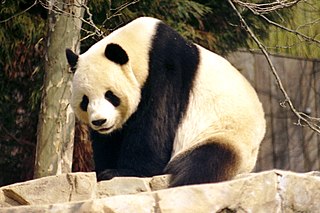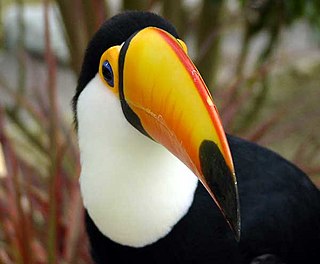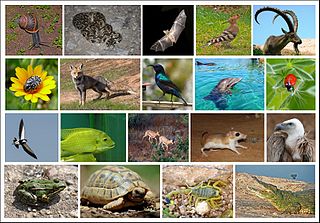Related Research Articles
This page features lists of extinct species, organisms that have become extinct, either in the wild or completely disappeared from Earth.
On 29 January 2010, the IUCN Red List of Threatened Species identified 5220 endangered species, subspecies and varieties, stocks and sub-populations.

Animals are multicellular eukaryotic organisms in the biological kingdom Animalia. With few exceptions, animals consume organic material, breathe oxygen, are able to move, reproduce sexually, and grow from a hollow sphere of cells, the blastula, during embryonic development. Over 1.5 million living animal species have been described—of which around 1 million are insects—but it has been estimated there are over 7 million in total. Animals range in size from 8.5 millionths of a metre to 33.6 metres (110 ft) long and have complex interactions with each other and their environments, forming intricate food webs. The study of animals is called zoology.
Version 2014.2 of the IUCN Red List of Threatened Species identified 4574 Critically Endangered species, subspecies and varieties, stocks and subpopulations.
On 30 January 2010, the IUCN Red List of Threatened Species identified 9694 Vulnerable species, subspecies and varieties, stocks and sub-populations.

A near-threatened species is a species which has been categorized as "Near Threatened" (NT) by the International Union for Conservation of Nature as that may be vulnerable to endangerment in the near future, but it does not currently qualify for the threatened status.

The wildlife of Brazil comprises all naturally occurring animals, plants, and fungi in the South American country. Home to 60% of the Amazon Rainforest, which accounts for approximately one-tenth of all species in the world, Brazil is considered to have the greatest biodiversity of any country on the planet. It has the most known species of plants (55,000), freshwater fish (3,000), and mammals. It also ranks third on the list of countries with the most bird species (1,832) and second with the most reptile species (744). The number of fungal species is unknown but is large. Approximately two-thirds of all species worldwide are found in tropical areas, often coinciding with developing countries such as Brazil. Brazil is second only to Indonesia as the country with the most endemic species.

A data deficient (DD) species is one which has been categorized by the International Union for Conservation of Nature (IUCN) as offering insufficient information for a proper assessment of conservation status to be made. This does not necessarily indicate that the species has not been extensively studied; but it does indicate that little or no information is available on the abundance and distribution of the species.
Threatened arthropods are defined here as any of a number of species within the phylum Arthropoda, whose extinction is likely in the foreseeable future. Estimating the number of threatened arthropod species is extremely difficult, primarily because a vast number of the species themselves are not yet named or described. Furthermore, according to Deyrup and Eisner, "The rate of destruction and degradation of natural habitats is currently so great that there are not nearly enough biologists to even catalog the arthropod species that are suddenly on the edge of extinction." In any case, independent estimates indicate that there are millions of undocumented arthropods on Earth.
The following outline is provided as an overview of and topical guide to zoology:

The wildlife of Israel includes the flora and fauna of Israel, which is extremely diverse due to the country's location between the temperate and the tropical zones, bordering the Mediterranean Sea in the west and the desert in the east. Species such as the Syrian brown bear and the Arabian ostrich have become extinct in Israel because of their loss of habitat. As of May 2007, 190 nature reserves have been established in Israel.

Pakistan's native fauna reflect its varied climatic zones.

An endangered species is a species that is very likely to become extinct in the near future, either worldwide or in a particular political jurisdiction. Endangered species may be at risk due to factors such as habitat loss, poaching and invasive species. The International Union for Conservation of Nature (IUCN) Red List lists the global conservation status of many species, and various other agencies assess the status of species within particular areas. Many nations have laws that protect conservation-reliant species which, for example, forbid hunting, restrict land development, or create protected areas. Some endangered species are the target of extensive conservation efforts such as captive breeding and habitat restoration.

A vulnerable species is a species which has been categorized by the International Union for Conservation of Nature that is threatened with extinction unless the circumstances that are threatening its survival and reproduction improve.
On 29 January 2010, the IUCN Red List of Threatened Species identified 6,702 data deficient species.

Fauna of Poland, according to the Polish Museum and Institute of Zoology, includes approximately 36,000 species. The most common type of fauna in Poland are arthropods (Arthropoda), and within the phyla, insects (Insecta) are most numerous.

Wildlife of Finland is affected by prevailing environmental conditions. Phytogeographically, Finland is shared between sosput, central European, and northern European provinces of the Circumboreal Region within the Boreal Kingdom. The territory of Finland can be subdivided into three ecoregions: the Scandinavian and Russian taiga, Sarmatic mixed forests, and Scandinavian Montane Birch forest and grasslands. Taiga covers most of Finland from northern regions of southern provinces to the north of Lapland. On the southwestern coast, south of the Helsinki-Rauma line, forests are characterized by mixed forests, that are more typical in the Baltic region. In the extreme north of Finland, near the tree line and Arctic Ocean, Montane Birch forests are common.
As of July 2016, the IUCN lists 32,383 animal species and 6,635 plant species as least concern. No least concern assessments have been made for taxa of other kingdoms.

Endangered species as classified by the International Union for Conservation of Nature (IUCN), are species which have been categorized as very likely to become extinct in their known native ranges in the near future. On the IUCN Red List, endangered is the second most severe conservation status for wild populations in the IUCN's schema after critically endangered. In 2012, the IUCN Red List featured 3,079 animal and 2,655 plant species as endangered worldwide. The figures for 1998 were 1,102 and 1,197 respectively.

The JapaneseRed List is the Japanese domestic counterpart to the IUCN Red List of Threatened Species. The national Red List is compiled and maintained by the Ministry of the Environment, alongside a separate Red List for marine organisms. Similarly drawing on the relevant scientific authorities, NGOs, and local governments, the Ministry of the Environment also prepares and publishes a Red Data Book that provides further information on species and habitats.
References
- IUCN 2009. IUCN Red List of Threatened Species. Version 2009.2. <www.iucnredlist.org>. Source of the above list (Downloaded on 12 March 2010):
